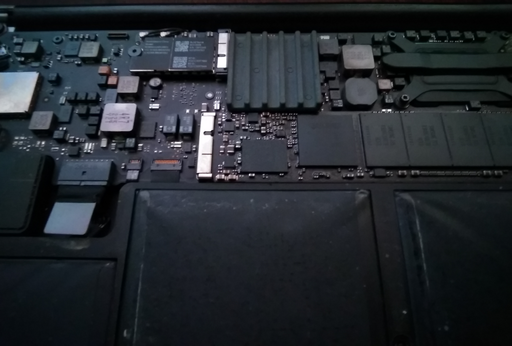Fixing MacBook Air Heat Issues
When disassembled, the MacBook Air 13" 2012 has the following disposition of components on the visible upper side of the motherboard right after taking the back cover off:
The first visible chip is an Intel 9 series chipset left of the CPU and the fan on the motherboard. As can be observed, the chipset does have a visible die exposed but there is no heatsink mounted on top such that only static air would provide cooling.
As it turns out, the chipset is a bunched collection of various components including the graphics controller, peripherials, etc making the chip sufficiently important to have better cooling.
The gap between the exposed chipset die and the back cover is approximately  which should allow a small heatsink shim to be inserted between the chipset and the backcover. Ideally, an added heatsink would transfer the heat between the chipset die and the aluminum backcover in order to dissipate heat on the entire surface of the Mac body.
which should allow a small heatsink shim to be inserted between the chipset and the backcover. Ideally, an added heatsink would transfer the heat between the chipset die and the aluminum backcover in order to dissipate heat on the entire surface of the Mac body.
Using a recycled ceramic heatsink and some double-sided heat transfer tape, the heatsink is added on top of the chipset die and the MacBook Air is put back together again. The ceramic heatsink itself had to be sanded down to fit the  gap between the chipset die and the backcover.
gap between the chipset die and the backcover.
As the datasheet claims, "The PCH may not operate above  " and even if the chipset will not reach that temperature, the heatsink should at least lower the temperature by a few degrees more. The advantage of using a ceramic heatsink is that ceramics are not electrically conductive such that in case the heatsink is dislodged and comes in contact with other components the motherboard will not end up shorted.
" and even if the chipset will not reach that temperature, the heatsink should at least lower the temperature by a few degrees more. The advantage of using a ceramic heatsink is that ceramics are not electrically conductive such that in case the heatsink is dislodged and comes in contact with other components the motherboard will not end up shorted.
For the contact, copyright, license, warranty and privacy terms for the usage of this website please see the contact, license, privacy, copyright.





